Stevens Avenue Project Summary
This page hits all the high spots, minus a lot of details.
1992-1993
Feb. 1992, Paula Craighead letter to Portland DPW about
slow speeds causing accidents gets things rolling.
July 6,1992: Traffic supposedly going too slowly. Deering Center
Neighborhood Association petitions city for traffic study.
$55,000 study done by DeLuca--Hoffman for city .
One year later, City now says traffic is going too fast. DCNA says "OK!!"
Study says that perception of neighborhood is that traffic is going too fast -- in reality it is not. (85th% of 34 MPH in 30 MPH zone equals no speeding problem.)
6 second wait to cross street is seen as too long.
Supposedly not enough gaps in traffic to cross street. 50 per hour is seen as
too few.
28 MPH is alleged in school zone at Longfellow grade school during child
transit times.
(Is 3-hour average of speeds taken in front of Deering High School, as
traffic can't move that fast when children present.)
Supporters move speed measurement 275 feet north to in front of Longfellow, but as it is in "SCHOOL ZONE", nobody checks.
(Ignored is that there have been no child deaths or injuries in 60 years in front of Longfellow due to traffic misbehaving. 2 deaths in 1975 and around 1951 are due to non-school kids running between parked cars.).
Only two accidents of 62 are caused by excessive speed: 2% . That occurs in Deering Center 300 feet away from the school.
One of those involves an ambulance, other occurs at 5 MPH.
All but one of 5 pedestrian accidents , take place at under 5 MPH, during winter months, in dark, around corners.
Fifth is elderly female crossing guard getting "struck" by car at
Woodfords intersection.
No injuries reported on 66-year old woman.
1993--1996
Paula Craighead , head of Deering Center Neighborhood Association (DCNA), and now head of the new Stevens Avenue Advisory Committee (SAAC), gets herself on roads classification committee being formed in Portland Area Comprehensive Traffic Survey (PACTS) office.
City has to classify roads within its urban area boundaries for FHWA, for future ISTEA funding. Paula is only “civilian” on board of roadway professionals, has zero experience in traffic engineering.
Stevens was at that time on short list of 10 major arterials being given from Portland DPW to state for federal listing.
Shortly after Paula made the board in early 1993, Stevens was taken off the major arterials list. Street has 14,500-16,000 cars a day, which is 3-5 times needed for major arterial status, according to FHWA.
Project slides through planning and funding process because nobody anywhere bothers to check city's data, which is all misrepresentation and lies.
City of Portland lies to feds in 1994 to get money from federal CMAQ program, funds of which are not to be used for safety projects.
Project never presented to public as clean air program-- is de facto safety project. Project is presented as clean air project to feds, safety never mentioned.
Project never checked by MDOT or DEP perhaps because Ronald Severance in the Maine Air Bureau was removed from state-federal oversight planning board by MDOT Director Melrose, which is violation of federal law. Dean Lessard takes over.
Project never checked by FHWA Region 1 in Albany NY, or in Washington. Boston EPA rubber stamps it too.
Funding supplied to DPW by unknowing FHWA
Oct. 1996-- first two humps installed at Longfellow Grade School and Walton St.
Engine 3 on Stevens starts breaking front springs: changes front suspension on truck 3 times in 9 months (twice in 20 years is normal).
1997
Asphalt medians, curbs, bumpouts, and chicanes installed from Deering High School to Morrills Corner.
Curbing eliminated parking in front of Longfellow, and Catherine McCauley HS.
Bumpouts put in at Concord, Tremont, Higgins, Brentwood, New, and Crosby.
Bumpouts (below right) cause traffic to pull into oncoming lane to get out, and prevents more than one car transiting at time, backing traffic up on Stevens. Accident due to this situation occurs on day after installation.
Road is chicaned (below left) at Evergreen Cemetery, and medians
installed near North end of street. City in uproar: largest political storm in
15 years. Deering Center erupts in protest.
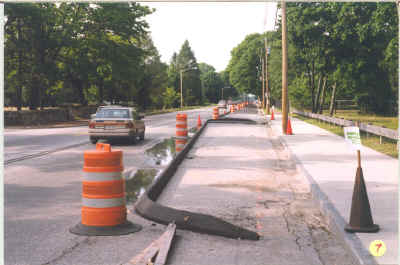 |
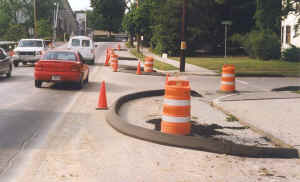 |
July 17, 1997--DPW head William Bray has first public meeting on appearance and effect of traffic calming program, at 808 Stevens Ave. Expecting 2 people, he got about 100. Sets date for larger meeting at Catherine McCauley HS the following week.
City somehow "loses" petitions against humps, which over 526 people signed. To be fair, it also lost the petition of the 30 people wanting humps. Illegal to not have on record, according to city clerk.
July 23,1997-- Contentious meeting at Catherine McCauley. Most people against project,--seen as ugly and useless. Meeting had 275-300 people, majority against.
Pro-hump Cynthia Lobenstein makes famous "it doesn't cost us anything, the
federal government pays for it." statement. Crowd groans.
Fire trucks hindered by medians, as are buses.
Fire dept. unhappy as they now will have to shovel 12 feet of snow instead of 3 feet, from curb to hydrants in areas of chicanes.
During winter, DPW says they will help people on Stevens shovel those 12
extra feet of driveway "in their spare time".
Copious DPW spare time during storms is news to myriad shovelers - they look for hidden meaning in statement.
Solution to child drop off problems at Longfellow Elementary School is to route
all traffic into Longfellow parking lot to drop kids, then cars will exit at
north entrance, crossing incoming traffic , to take left onto W.
Concord, exiting through neighborhoods where kids are walking to school.
Or, go right out of lot, right again on Pleasant, then right or left at Stevens
joining other cars on street.
174 cars and three busses in 30 minute period are expected. Increased traffic through side streets upsets neighborhood.
Other solution is to turn left or right off Stevens onto Concord, Tremont, drop
kids off to cross "dangerous" street, then exit through neighborhoods, where
kids are walking to school.
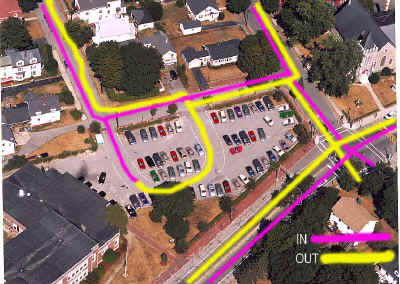 Increased
traffic upsets neighborhood.
Increased
traffic upsets neighborhood.
This picture shows the traffic pattern at Longfellow Grade School that about 175 cars and 4 busses would have to negotiate in a 20 minute period during school let-in times, according to supporters. Purple is incoming, yellow is outgoing.
Medians at North end of Stevens eliminate parking in front of businesses, and block buses and fire trucks from getting through. Churches now have parishioners making U-turns at bakery outlet to get to church.
Councilor Peter Rickert launches plan to remove the asphalt curbing .
Paula Craighead, SAAC and DCNA head, bails on DPW head Bill Bray, quitting SAAC. Gives one line resignation Aug. 5, 1997.
Aug 6, 1997
Curbing, chicanes and medians scraped off road.
About $250,000 spent so far.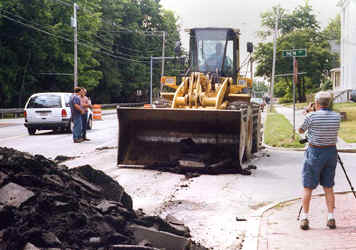
Off to Plan B.
Sept.-Oct. 1997
Portland City Council / DPW contention is that other communities have hump projects that work well: Oregon, California, England cited.
Called those places: all have problems politically, and their humps are being removed or are stopped because people don't like them.
Whatever the case, NO HUMPS ARE BEING INSTALLED ON EMERGENCY ROUTES.
Proponents in cities contacted are citing each other as very successful, but not checking facts!
All traffic offices and project heads in all cities contacted say they would not install humps on Stevens
All fire departments in all cities protesting / not allowing humps on emergency vehicle response routes.
All government agencies (ITE, NTSB-OHS, FHWA, AASHTO-geometric design task force) say humps should not be on road.
Stevens Ave. is seen as one of top 3 traffic engineering disasters in US for 1997 (says NY and Md. DOTs)
Accidents take an immediate 58% jump upon hump installation-- serious injury accidents increase 300%.
City council meetings are held . Council votes to leave humps on road for winter
to "get experience" with them, but also promises to take them off the
road by May 1, no matter what.
Fall 1997:
City council has sessions, most people against humps. City Councilor Charles Harlow has illegal meeting (unannounced to public) at Northgate about Phase II- What to DO?.
FHWA CMAQ head Savonis launches FBI investigation into creation of SAP and who signed what, because of funding irregularities.
FBI determines project is "fraud and misuse of government funds" Only reason FBI not indicting Portland DPW and MDOT under RICO statutes is because FHWA CMAQ head Savonis labels the whole thing an "experiment" . Jails would fill up.
Ronald Severance at Maine Air Bureau is all gung ho to refute SAP until he finds out he signed off on it without checking details. He starts backpedaling. Sends me air model of Stevens, saying that 25 MPH is "most efficient speed", even though model shows that most efficient speed starts at 31 MPH! EPA says so too.
Statement is heard that it's "safer to be run over at 25 MPH than 30 MPH."
Winter 1997:
First slick snowstorm Nov. 14th: traffic backed up from speed table at Pleasant Ave, all way to Congress, which backed up to State St. (2 miles!). Traffic getting stuck on ramp, due to increased grade. Lasted 6 hours, till City salted it.
Longfellow crossing guard (Mr. Rench) is forbidden from shoveling snow off hump by his boss. City will not cover him if injured while shoveling. Children now walking in street to get to crosswalk.
1998
Accident levels stay at 58% increase. Controversy about value of humps continue.
Federal Highway Administration pulls funding from Phase II of Project, as it finds that the project increases air pollution. City declines to remove project as it said it would do in original funding request.
City says no action will be taken until May 1998: traffic counts to be done, to start final monitoring of project.
Checked DPW: Nothing planned on May 1, when I asked traffic engineer Larry Ash about study, but counting tapes out all of a sudden on May 4. Counts done by DeLuca-Hoffman, designer of project.
City's own final report says auto accidents up 58%,
2,500 cars a day are diverted elsewhere
pedestrian and bike usage down 8% ,
pollution increasing 46-400% because of braking and acceleration at humps--17 more tons or pollution being generated per year according to city figures; 125 tons according to feds.
6 second pedestrian crossing delay now down to 1.5 seconds..
Fire dept. tests trucks and ambulances on humps at various speeds and finds that they cannot safely go over humps at more than 15 MPH; Ambulances 20 MPH. Stretcher bounces off rack at 32 MPH.
No Fire dept. personnel thinks humps are good, other than chief.
All rescue chiefs around Portland believe humps a threat to patient transport.
Chief says "no negative impact on response time or operations". All other department members disagree.
Engine 3s response time is severely delayed : 1-3 minutes at end of run area, according to fire crews.
Patients in ambulances falling to floor seen as "negative" outcome by all, other than Chief Thomas, soon to retire.
Department as a whole hates speed humps.
1999
Accidents still up 40%
Chief Thomas retires to State Fire Planning Board.
City Council lets it be unofficially known that anybody who does not follow party line on humps will be fired or disciplined.
March 29, 1999---Portland Traffic Calming Ordinance enacted during Council
meeting.
Councilor James Cloutier successfully amends ordinance before the vote,
removing the Stevens project from the purvue of the ordinance so as to
allow "study" of effects on traffic and environment.
Neglects to say that there is no money put aside for the studies, so they will never be done, and that public sentiment against the humps is so high that they would vote it off the street that day.
Councilor Charles Harlow, inceptor of the project, says he has severe
reservations about breaking public promise to remove humps if not liked by
public, or funded by the FHWA.
Portland ordinance now at Maine Dept. of Transportation as model for state traffic calming plan. Makes the rounds of departments for a month or two, then is shelved due to no interest elsewhere in state.
2000
Accidents still up 40%. Public thinks humps are "stupid".
Woman calls DPW- told that humps "were never meant to be removed " (somebody told the truth finally.)
2001
City still unofficially maintains Stevens project as success. Does not tell public about problems, on purpose.
May 6- Because of "success" of Stevens Project, Brighton Avenue narrowed to one lane to placate 30 households who feel that traffic is speeding (doing 40 in 35 mph).
Narrowing accomplished despite City traffic engineer Larry Ash, DPW head Bill Bray, and project designer Thomas Gorrill recommending against project. Ash had called Federal Highway Administration and knew better. Gorrill already knew.
Traffic now doing 40 mph in one lane.
Alleged environmental protection organization National Resources Council of Maine called for opinion of increased air pollution.
Air quality head Sue Jones says situation is deplorable, until told that Portland City Council wanted it done. She cuts off talk, saying that nothing could be done about it.
Doesn't bother to tell me that Karen Geraghty, Portland City Councilor and ardent speed humper, is their lobbyist.)
Situation, if not the air, gets clearer.
2002
State calming plan still on shelf. Dust bunnies growing on top.
In other calming news:
Continuing the "success" of Stevens Project
(city still not talking),
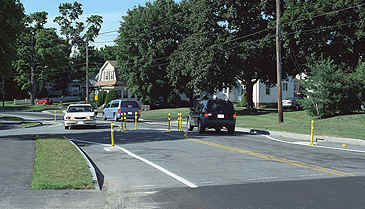 traffic circles
traffic circles
installed
July 7th, at a cost of $7,000 in 3 separate intersections on Capisic
Street to solve alleged speeding problem.
Project consists of set of three 8-foot-diameter, 2" high concrete pads, with a series of outlying 3" raised concrete bumpers with "Safe-Hit" plastic pylons to channel cars, set in plastic bases next to the bumpers.
The pylons were cut in half the next week: Kids with cars were using the pylons for target practice. Others could just drive through the circle without slowing. Neighbors off the main road were blocked from safely entering Capisic. Public uproar grew.
The third week, the pylons were removed completely. Trucks were grinding
and crushing the pylon bases, and ripping the pylons from the
bases.
$7,000 for three weeks of useless bother.
At the same time, $600,000 was cut from the school budget because of "no money".
Plans were to grind the concrete back down to the pavement level, and eliminate the circles. Done.
Public meetings held at Breakwater School to formulate new plan of action. Speed humps are at the top of the list. Councilor Nathan Smith declines to tell public truth about speed humps, when they are mentioned.
2003
September-November- Portland Transportation Committee starts thinking about decreasing percentage of people on street needed to support speed humps upon petition. 51% will be new level, instead of standard 75%.
City Traffic Engineer Larry Ashe dies of complications from back surgery.
2004
November: Speed humps installed on Capisic Street at cost of $6,200. Can still be driven over at 40 mph.
Police worried about single hump near new culvert installation on eastern end of Capisic. Due to engineers forgetting about diameter of culvert, there is now large hump in road just before speed hump when traveling west to east. Police feel this is very dangerous situation as hump is unseen until atop culvert. City ignores problem.
2005
Councilor James Cloutier still pushing special interest projects: the redesign of Deering Oaks Park for the Friends of Deering Oaks. FDO head Anne Pringle and compatriot Steven Scharf of the Bayside Neighborhood Association ramrod redesign through Peninsula Traffic Study Committee, headed by friend Cloutier.
Project will cost $8,500,000 - $37,000,000 and cause massive traffic congestion, air pollution, and loss of intersection service in most of middle of City, with no increase in public welfare. 46% of parking in Parkside area will be eliminated; an area of heavily populated apartments and houses.
Project requires waiver of 25 years of environmental laws like the Clean Air
Act, and ignores various federal and state laws concerning funding, validity of
documentation, and official statements.
March 17 --Scharf : maintains that if "any federal or state laws (state and federal environmental or engineering laws) interfere with the construction of this project they should be ignored or changed".
May 12th : Federal and state highway engineers express strong skepticism about viability of project. Feds and state say they will not be funding it. Up to city to find money.
Scharf states that purpose of project is to cause traffic congestion in area, so that motorists will not want to travel through Bayside. States: "We don't want people driving through our neighborhood"
2012
Cities new effort to upgrade Forest Avenue as delineated in draft form : "Transforming Forest Avenue" (Att. A, page 2, sentence 3) raises the specter of the disastrous Deering Oaks Project coming back to life.Tegin Teich of Boston's IBI Group consultants in a June 30, 2011 memo; page 2,B-3 to Portland Planning repeats the interest in the Oaks project. Some people just don't get it.